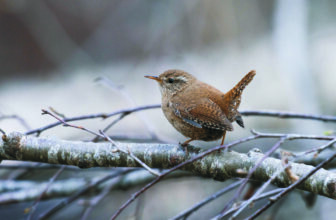
European Nightjar, Caprimulgus europaeus.
When a good mate of mine used to tell his wife he was popping out with me for a ‘Nightjar’ she later revealed she always thought this was code for going down the pub.
She was wrong, although her suspicions were no doubt well-founded.
In fact we would be setting off shortly before dusk to a suitable Waverley or Hurtwood heath for arguably one of the greatest birding spectacles to be enjoyed around Cranleigh.
The bark-coloured and hawk-like Nightjar is a bird of mystery. Nobody seems to know exactly where in Africa they come from. And because they are birds of the dusk, dark and dawn, most people are unlikely to encounter one – unless they come across one by accident.
This happened to another non-birding friend of mine who was taking a short cut walk home one still summer night – yes, from the pub of course. He told me his route took him around Holmbury Hill and in the eerie midnight silence he was suddenly frightened out of his wits.
He never actually saw the bird. Just heard it. I was able to confirm he’d encountered the voice of the Nightjar – the weirdest song of any bird I have ever heard. It can carry over half a mile away so if you hear it close up and don’t know what it is then you sure are likely to be startled.
The male gives a mechanical ‘churring’, like a generator, from a suitable post or Scots Pine branch.This breeding season song is made up of as many as 32 notes a second.
The pitch can rise and fall and continue for minutes on end throughout the night. But where is it coming from? The Nightjar is like a ventriloquist. It always reminds me of Queen’s Freddie Mercury’s great performance of ‘Now I’m Here’:
‘Here I stand (here I stand),
Look around around around around around,
But you won’t see me (but you won’t see me)
Now I’m here (now I’m here),
Now I’m there (now I’m …:’
At the end of each session the Nightjar’s tone seems to change down into a lower gear as if he is conking out of electricity. Then after he grinds to a halt you might well see him against the pink sunset as he flies to another song post.
But flights are never that simple. The male claps his wings together to attract female interest and invariably announces his name with a call that sounds like ‘Eric’. And then there follows a frenzied duel in the dark as ‘Erica’ – and others – chase around like uncontrolled model aeroplanes over the heather and bracken.
Not surprisingly, there is much folklore attached to this enigmatic bird – and it has many old country names. In Surrey these include Evejar, Heath-Jar, Night Swallow and Puckeridge.
It has also been called Goat Sucker. The first part of its Latin name Caprimulgus europaeus comes from capra (a nanny goat) and mulgere (to milk). Country folk at one time, mistakenly, blamed it for sucking milk from the udders during nocturnal visitations.
In fact the Nightjar, which was back and performing near Cranleigh on the early date of 8th May this year, can be very amenable. I’ve often managed to attract them, using natural impersonation, to fly just feet above my head.
When they are inquisitive like this their flight is silent, and buoyant, and they will display by circling round even a group of people who have been prepared to wait quietly to greet them. So impressive!
As with many of our birds, the Nightjar is threatened and there are probably under a dozen pairs left in this vicinity. You can help their future by keeping yourself and any dogs to the heathland paths.
Of course your pet is lovely and wouldn’t hurt a fly – but it might disturb a nesting bird. And that’s something the watching Crows, who prey on the eggs and nestlings, are looking out for.
Twitter – @Crane_Spotter











